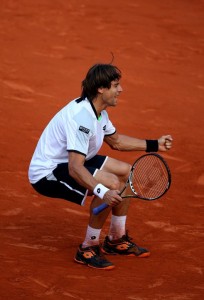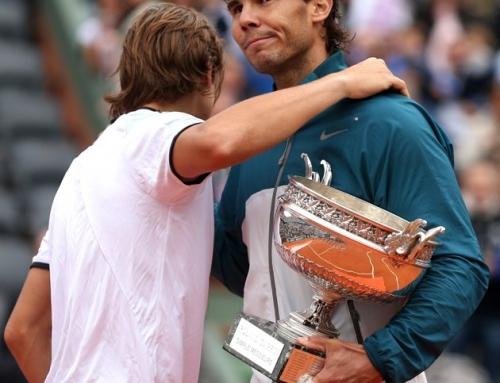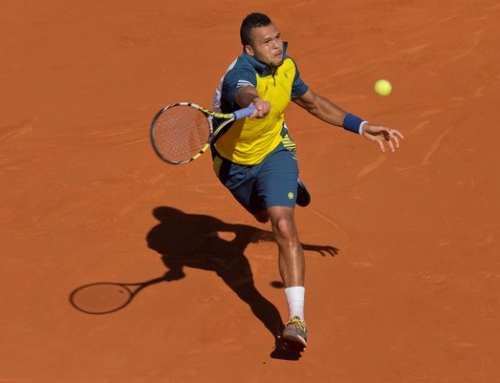 When the draw came out, nearly two weeks ago, everyone wondered which half Rafa would fall in. As the number 3 seed, Rafa had the chance to be in Djokovic (the top seed) half or in the Federer (number 2 seed) half. When he was in the Djokovic half, many felt that this was a huge gift to Roger Federer. With Murray skipping the French due to a back injury (which might not matter much since clay is his weakest surface), the field looked wide open in Federer’s half.
When the draw came out, nearly two weeks ago, everyone wondered which half Rafa would fall in. As the number 3 seed, Rafa had the chance to be in Djokovic (the top seed) half or in the Federer (number 2 seed) half. When he was in the Djokovic half, many felt that this was a huge gift to Roger Federer. With Murray skipping the French due to a back injury (which might not matter much since clay is his weakest surface), the field looked wide open in Federer’s half.
The only pesky player along the way appeared to be Jo-Wilfried Tsonga. Tsonga had, of course, given Federer trouble before, most notably in the 2011 Wimbledon, where he came from two sets down to beat Federer in the quarterfinals. But, this was clay, and Federer had been known, at one time, as the second best player on clay (mostly because he kept being runner to Rafa). That moniker, to my mind, is no longer true. Djokovic has been the second best clay player for some time, perhaps dating as far back as 2009, despite the 2011 French Open where Djokovic lost to Federer in the semifinals.
Now, it turned out Tsonga was Federer’s undoing, and so that traipse to the final never happened.
But it turned out there was another guy who benefited greatly from Murray withdrawing, and that was David Ferrer. As much as everyone marvels how such a small guy with no huge weapons plays such big tennis against the biggest players, in the back of many fans minds is that Ferrer just isn’t good enough to beat the big guys.
Just to give you an indication of this, let’s look at the relatively short history of David Ferrer slam semi.
Despite Ferrer’s rather lengthy career and his success on clay, Ferrer’s first semi at a Slam came in 2007 in the US Open where he upset Rafael Nadal in the fourth round (intriguingly enough, he beat Tsonga in the 3rd round). After being Chela in the quarterfinals, Ferrer lost in straight sets to the suddenly surging, Novak Djokovic, in straight sets.
Ferrer wouldn’t reach another Slam semi until 2011 when he reached the 2011 Australian Open semifinal. There, he beat Rafael Nadal in the quarterfinals, but Nadal was visibly hurt, so Ferrer won in straight sets rather easily (something he’s done since then). Murray would be Ferrer in four sets to reach his second Slam final.
2012 has been, up to now, Ferrer’s best year in the Slams. He reached the French Open semifinal where he was crushed by Rafael Nadal. Nadal would go on to win his 7th French Open title over Djokovic in the finals. Ferrer then reached the semis of the US Open with an epic quarterfinal match against Janko Tipsarevic to meet Novak Djokovic in the semis. Due to very windy conditions, Ferrer actually took a set off Djokovic, but the match got delayed and Djokovic won the match in nicer conditions in four sets.
In 2013, Ferrer reached the Australian Open semi once again. This time, with Rafa out of the main draw (as was the case at the US Open), Ferrer had his own quarter. Ferrer had to do some Houdini to get out of his match against Almagro who was using his power to dictate against Ferrer, but Ferrer, as he does, kept hanging on, kept winning points, and Almagro’s mental frailty at the end of the match came forth, and Ferrer made it to the semis where he was crushed by Djokovic in a score similar to his French Open semi loss to Nadal the year before.
By the French, Ferrer again had his own quarter, this time, courtesy of Andy Murray dropping out, and he had the fortune to fall on Roger Federer’s half. Federer has had his way with Ferrer for some time, and so that match did not favor the diminutive Spaniard, but Federer didn’t live up to his end of the bargain. Instead, the talented Frenchman, Jo-Wilfried Tsonga, beat Federer in straight sets, and this opened up a chance for David Ferrer.
You see, up to this point, he had lost to Djokovic (three times), to Nadal (once), and to Murray (once). Admittedly, he had never faced Federer in the semis, but his chances would have been poor. Tsonga, by contrast, he had a winning record, albeit a 2-1 lead, but certainly, it was a lot better than any of other top seeds playing.
So as much as Federer got to avoid playing both Djokovic and Nadal, Ferrer also benefited from this.
Now, the French public, eager for another French winner, 30 years after Noah was the last French player to win Roland Garros, lavished the praise on Jo-Wilfried Tsonga. Fans of Tsonga and indeed fans of anyone who wanted either Djokovic or Nadal to lose hoped the hard hitting Tsonga would plow through the Spaniard and provide the only reasonable challenge to a near foregone conclusion-that either Djokovic or Nadal would win.
And so, despite the respect Ferrer gets, he doesn’t really get respect. Many people favored the Frenchman, with his new coach, Roger Rasheed to upset the higher seed.
However, Ferrer was having none of that, and he only succeeded because honestly, Tsonga couldn’t keep up with Ferrer. Ferrer outsteadied and out ran the Frenchman who, when compared to the earlier semifinal epic, looked rather lethargic and likely would have provided neither Djokovic nor Nadal a proper challenge. In numerous backhand exchanges, Ferrer would often win after 7-10 shots while Tsonga made an error. It’s Tsonga’s inability to play long ralliers while hitting hard (something Monfils does better, by the way) that allowed Ferrer to control the match.
Within a blink of an eye, Ferrer was up 5-0 in the first set, and eventually won 6-1. The second set started promising for Tsonga at 3-0, but Ferrer had it tied up 3-all when Tsonga got irritated by a call, lost focus, and his serve. The second set went into a tiebreak where Ferrer got an early lead. Tsonga managed to get back a few points, but Ferrer closed out efficiently.
By that point, the crowd, seeing Tsonga unable to overpower Ferrer, nor able to stay in extended rallies with Ferrer, were probably thinking this was not the year a Frenchman would reach the finals. At the very least, Noah was huge and imposing, and in those days, you could serve and volley, even on clay. Tsonga might have been vulnerable to another player or two in the tournament, and everyone, alas, underestimates Ferrer.
Ferrer claimed an early break and eventually got a second one and won 6-2 to reach his first Slam finals.
Ferrer briefly fell to the ground in utter amazement and happiness. This was perhaps Ferrer’s reward. His record against Nadal is not very good, although he has had some success against him in Slams, once because Nadal had yet to the tough guy on hard courts he is now, and once due to an injury. Ferrer will have to hope Nadal is far from his best, because the tennis that either man played in the other semi was better than what Ferrer produced. Ferrer lacks the laser precision of Djokovic or Nadal often dumping shots in the middle of the court when he senses trouble, and while this doesn’t hurt him against mot players, it creates problems for him against players like Nadal and Djokovic.
But, alas, it will be Ferrer, not Nadal, who comes to the finals without having dropped a set. Nadal dropped 4 sets along the way, one set in round 1, one set in round 2, and two sets in the semis. Admittedly, Nadal also had the much tougher route to the finals as Tsonga was Ferrer’s only top twenty opponent.
Congratulations to David Ferrer, having the best moments of his career, for reaching his first Slam final.




![[French Open] The tactics of the Djokovic-Nadal semifinals](https://www.essentialtennis.com/wp-content/uploads/2013/06/20130607nole-500x383.jpg)
![[French Open, SF] Nadal escapes epic 5-setter with win over Djokovic, to compete for 8th title](https://www.essentialtennis.com/wp-content/uploads/2013/06/20130607rafa-500x383.jpg)

![[French Open, QF] Djokovic and Nadal to play in epic semifinal encounter](https://www.essentialtennis.com/wp-content/uploads/2013/06/20130605nole-500x383.jpg)